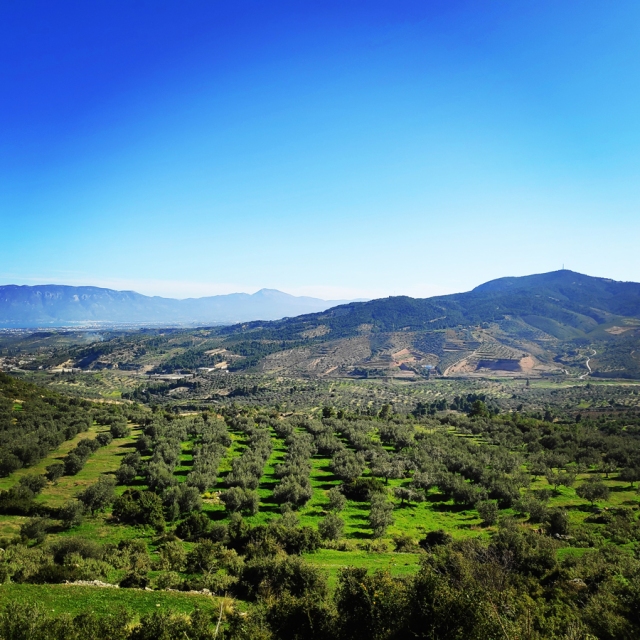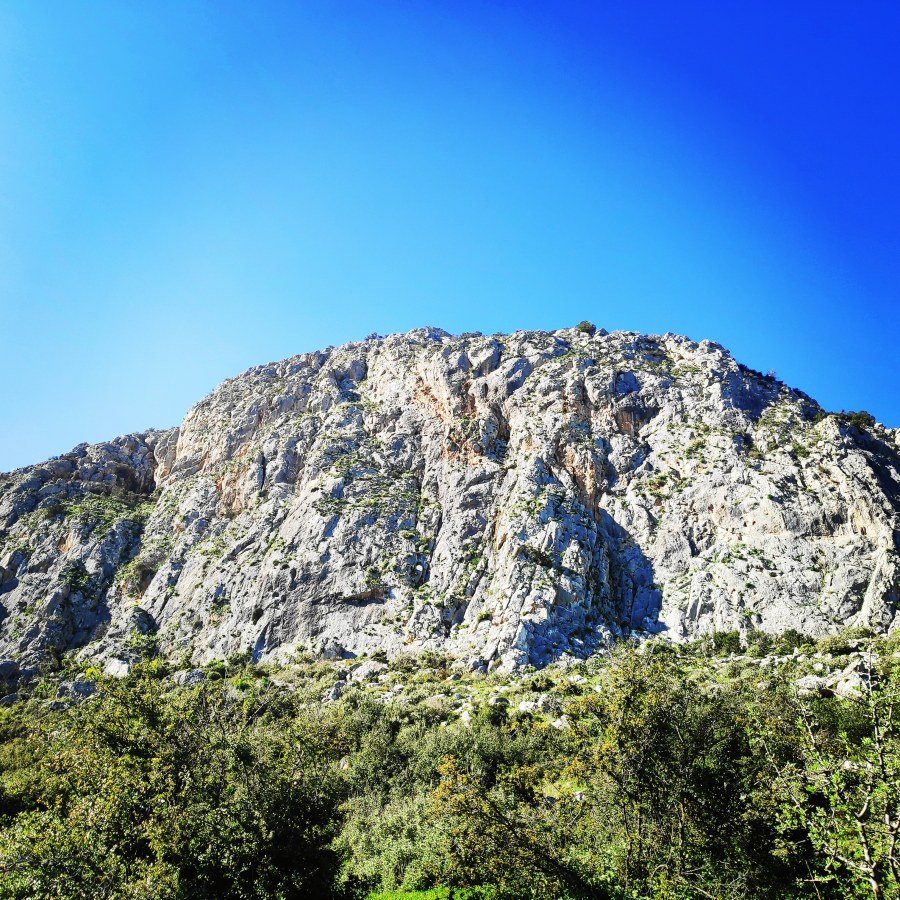Solomos (or Tsouba) is located south of Corinth, near the homonymous village of the prefecture of Corinthia.
The crag had begun to be created since 2005, but recently a wide maintenance and enrichment with new routes was carried out by the mountain guide Dimitris Titopoulos, following actions and support from the EOS of Corinth and the Municipality of Corinth.
The crag is located in a quiet spot above the orchards with the olive trees, with beautiful views towards Akrocorinthos and the Corinthian Gulf. Akrocorinthos is a steep rocky hill that dominates the Corinth plain. It was the fortified citadel of ancient and medieval Corinth.
Solomos was discovered in 2005 as a climbing crag by K. Thomas who, along with A. Bosco, began to open the first two routes.

About Solomos Crag
The rock is mostly compact gray limestone of excellent quality, scattered by convenient small pockets. The routes are very well secured and are mainly aimed at young climbers.
Route ratings vary mainly around 5a-6b, but there are some more difficult routes, up to 7a. Protection bolts are generally dense, ideal for young climbers and climbing courses.
Climbing is mainly technical with a wide variety of movements. Routes that are referred to as trad (traditional) are not equipped with bolts and need wires and friends.
All names are clearly written at the base of the routes.




Approach to the crag of Solomos
Access: From the Athens – Patras highway, exit to Ancient Corinth and follow the old national road Corinth – Argos to the south, heading to the village of Solomos (5 km away from the National Road). At 400m from the entrance to the village we meet a church on a branch of the road and there we turn right to move along the lines of the train.
After 600m, in a new junction, we turn left towards Ag. Paraskevi and continue on the same road until we reach the top of a hill with olive trees, where the field appears to our right. There, right from the road, among the olive trees, there is a clearing that offers plenty of space for many cars, although summer can be plowed. All in all, the distance from the entrance to the village is 3.5km.
Walk in: From the parking area, walking is required 5 minutes to the base of the routes.
Season: All year round. During winter time, is best to climb from early morning. During summer time is best to climb after 14.00.




Routes on Solomos Crag
|
Name |
Grade |
|
Grifos |
6b+ |
|
Crack |
5c (V+) |
|
Whitehorse |
6a+ (VI+) |
|
Apoleia Euro |
5c (V+) |
|
Jacuzzi |
6a+ (VI+) |
|
Isorropistis |
6b |
|
MSM |
6b |
|
Kyriakatiko Proino |
5c (V+) |
|
Isthmos |
5c (V+) |
|
Pegasus |
6a |
|
Kalamaki beach |
6c+ |
|
Eros |
7a |
|
Mousa |
6b+ |
|
Voyager |
6b+ |
|
Voyager 2nd pitch. |
5b (V) |
|
Eos Korinthou |
6b+ |
|
Travmatismenos Theatrinos |
5c |
|
Zouzouni |
6a+ |
|
Telosss |
7a |
|
Bosch |
5a |
|
Bosch ext. |
6a+ |
|
Poulimeni Pseira |
7a |
|
Paragelia |
6a |
|
Paragelia ext. |
6a |
|
O Phovos tis Drahmis |
5c (V+) |
|
Nychterini |
5c |
|
Luna |
5c |
|
Luna ext. |
6a |
|
Pandora |
4c |
|
Hara |
5a |
|
Mavri Apolafsi |
5b |
|
Mavri apolafsi ext. |
6b+ |
|
Lais |
6a |
|
Demeden |
5b |
|
Maggi |
5c |
|
Gripi |
6c |
|
Trypitsa |
5b |
|
Trypitsa ext. |
6b |
|
Oraia |
5b |
|
Oraia ext. |
6b+ |
|
Faskomilia |
5b |
|
Alfa |
5b |
|
Alfa ext. |
6b+ |
|
Veta |
5c |
|
Veta ext. |
6c |
|
Monaxia mou ola |
6c+ |
|
Organomenos havales |
5a |
|
Koutsi maria |
4c |












What else to do near Solomos Crag
Once in Solomos crag, one can also have a great experience with the ancient greek culture but also some nearby hiking activities.
Ancient Corinth:
Corinth was a city-state (polis) on the Isthmus of Corinth, the narrow stretch of land that joins the Peloponnese to the mainland of Greece, roughly halfway between Athens and Sparta. The modern city of Corinth is located approximately 5 kilometres (3.1 mi) northeast of the ancient ruins. Since 1896, systematic archaeological investigations of the Corinth Excavations by the American School of Classical Studies at Athens have revealed large parts of the ancient city, and recent excavations conducted by the Greek Ministry of Culture have brought to light important new facets of antiquity.
For Christians, Corinth is well-known from the two letters of Saint Paul in the New Testament, First and Second Corinthians. Corinth is also mentioned in the Acts of the Apostles as part of the Paul the Apostle’s missionary travels. In addition, the second book of Pausanias’ Description of Greece is devoted to Corinth.
Ancient Corinth was one of the largest and most important cities of Greece, with a population of 90,000 in 400 BC. The Romans demolished Corinth in 146 BC, built a new city in its place in 44 BC, and later made it the provincial capital of Greece.
Acrocorinth:
Acrocorinth, “Upper Corinth”, the acropolis of ancient Corinth, is a monolithic rock overseeing the ancient city of Corinth, Greece. “It is the most impressive of the acropoleis of mainland Greece,” in the estimation of George Forrest. Acrocorinth was continuously occupied from archaic times to the early 19th century. Along with Demetrias and Chalcis, the Acrocorinth during the Hellenistic period formed one of the so-called “Fetters of Greece” – three fortresses garrisoned by the Macedonians to secure their control of the Greek city-states. The city’s archaic acropolis, already an easily defensible position due to its geomorphology, was further heavily fortified during the Byzantine Empire as it became the seat of the strategos of the thema of Hellas and later of the Peloponnese. It was defended against the Crusaders for three years by Leo Sgouros.
Afterwards it became a fortress of the Frankish Principality of Achaea, the Venetians and the Ottoman Turks.
With its secure water supply, Acrocorinth’s fortress was used as the last line of defense in southern Greece because it commanded the Isthmus of Corinth, repelling foes from entry into the Peloponnese peninsula. Three circuit walls formed the man-made defense of the hill. The highest peak on the site was home to a temple to Aphrodite which was converted to a church, and then became a mosque. The American School’s Corinth Excavations began excavations on it in 1929. Currently, Acrocorinth is one of the most important medieval castle sites of Greece.
Hiking in Geraneia Mountains:
Mount Geraneia is a mountain range in Corinthia and West Attica, Greece. Its highest point is the peak Makryplagi, elevation 1,351 m. It covers the northern part of the isthmus between the Gulf of Corinth and the Saronic Gulf. It spans 5–10 km from north to south and 30 km from east to west.
The geography of Geraneia includes forests in the south, the west and the northern part at an elevation of under 900 to 1,000 m. Barren land is in the central part. The grasslands and some bushes lies to the northwest. Farmlands and some barren land lies to the south.
- Spring Training Ascent on Geraneia Mountains
- Summer in Geraneia Mountains
- Geraneia mountains & Sanctuary of Hera
For more info in greek language, you can visit the website of Vrachomania.gr

Looks like great rock to climb on😍
LikeLike
It’s a really nice spot indeed!
LikeLike
Pingback: Climbing in Charamos Crag – Kandia – Argolis, Greece – Olympus Mountaineering
Pingback: Climbing in Charamos Crag – Kandia – Argolis, Greece (Update 2023) – Olympus Mountaineering